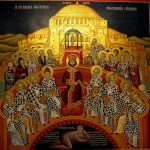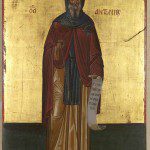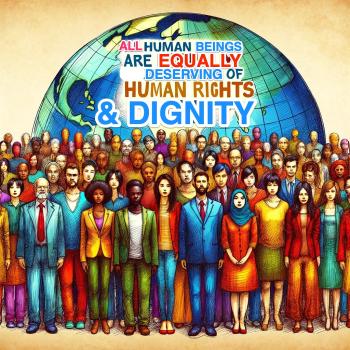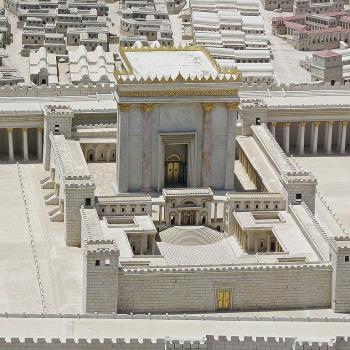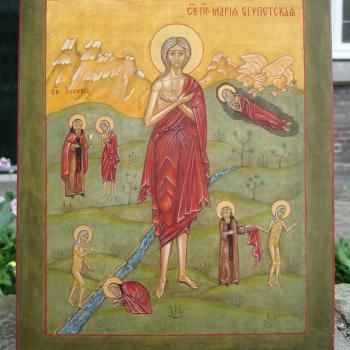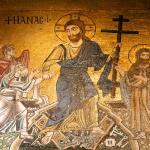![Woodcut of City of God by St. Augustine of Hippo [Public domain], via Wikimedia Commons](https://wp-media.patheos.com/blogs/sites/637/2017/05/De_Civitate_Dei_The_City_of_God_1475-300x200.jpg)
A further question arises whether it was from one of the sons of Noe or from Adam himself that human monsters have sprung. At any rate, the history of many peoples records that there have been, for example, beings with one in the middle of their forehead, and others with feet growing backwards; the Hermaphrodites with the left side of their chest like a woman’s and the right side like a man’s and who exercise in turn the male and female functions in begetting and bearing offsprings; others, who have no mouths, breathe only through their ears and live on air; others, no more than a few feet high, are called Pygmies, from the Greek word pygme meaning an arm’s length; others, whose women conceive when they are five and die before they are eight years old. They also speak of a people who have but one leg with two feet and who can run with remarkable speed without bending a knee. They are called Sciopedes because they lie on their backs in the summer and they keep the sun off with their feet. There are others who are neckless and with eyes in their shoulders; and so for other kinds of men or near-men who are depicted in the mosaics to be seen in the square near the seafront at Carthage, all of which are taken from books dealing with the history of curiosities. [4]
It is because of his belief in the common origins of humanity, and that all such humanity shared one common human nature, starting with Adam, he said all such creatures should be seen to have come from Adam and deserve to be called human: “It would be impossible to list all the human offspring who have been very different from the parents form whom they were certainly born. Still, all these monsters undeniably owe their origin to Adam. The same is true of whole nations.” [5] It’s not just individual persons, but whole nations which he believed could be formed with differences, showing the foundation of evolutionary thinking. The difference between Augustine and Darwin would be how rare the change could be, and the mechanism of that change, for Augustine would say it was God who was behind it all. Thus, he reiterated, “It need not seem inconceivable to us, then, that just as there are individual monsters in every nation, so there might be whole nations of monsters in the totality of mankind.” [6] There can be whole offshoots which develop from humanity, which form their own distinct nations, offshoots which would still be accorded human dignity but today would probably be classified as evolutionary changes which could result in the formation of new species.
Augustine had no problem with development of “whole nations of monsters,” who were human, who deserved to be understood and treated as human, but who were quite different from the rest of humanity. They could have had minor differences, such as the number of fingers they had on their hands, or major transformation so they would be like many of the curiosities found in various historical legends he had read; the key was that God had allowed for the changes and that such monsters need not be seen as horror; they were, rather, wondrous representations of what God can do with humanity, and their differences could be seen as a part of God’s greater aesthetical accomplishment in the world.
Augustine allowed for the development of monsters from human stock, those entities which differed from the rest of humanity. He agreed with his contemporaries that they were marvels, which, when witnessed, could portent some message from God. That message need not be indication of some great evil or tragedy, as many of the ancient superstitions suggested; rather, it could be an indication of the glory of God and how he wanted a diversity within humanity to express the beauty of humanity and the many ways that beauty could be expressed. Certainly, Augustine was not opposed to the notion that some of these monsters could have been formed as the result of sin, since Scripture suggested the race of giants was made possible because of the sins of the “sons of God,” but this was not a universal rule.
God allowed for diversity and this should be a marvel to us. This diversity should serve as a representation of the bountiful goodness and beauty of being. While not following the mechanisms suggested by modern science, Augustine had a concept of evolution, one not done through natural selection but by God, and so he gives to Christianity an ancient ground by which we can reflect upon evolution today. It does so without so-called Social-Darwinian thought which created racist narratives in the early twentieth century. Unlike modern scientists who have no metaphysical and moral ground to work with, Augustine showed us that whatever the differences, humans all deserve respect and their differences should be seen as a reflection of God’s glory in the world to be preserved instead of as defects which must be eradicated by any means possible. Eugenics denies the glory of being because it does not understand the great chain of being which is reflected in difference. Only by realizing and accepting such differences does the beauty of God’s created order truly become known.
[1] J. R.R. Tolkien, Beowulf: A Translation and Commentary. Ed. Christopher Tolkien (Boston: Houghton Mifflin, 2014), 16.
[2] St. Augustine, City of God Books VIII-XVI. Trans. Gerald G. Walsh, SJ and Mother Grace Monahan OSU (New York: Fathers of the Church, Inc., 1952), 502 [XVI.8].
[3] St. Augustine, City of God Books XVI – XXII. Trans. Gerald G. Walsh, SJ and Daniel J Honan (New York: Fathers of the Church, Inc., 1954), 362 [XXI.8].
[4] St. Augustine, City of God Books VIII-XVI. Trans. Gerald G. Walsh, SJ and Mother Grace Monahan OSU (New York: Fathers of the Church, Inc., 1952), 501-2 [XVI.8].
[5] St. Augustine, City of God Books VIII-XVI, 503 [XVI.8].
[6] St. Augustine, City of God Books VIII-XVI, 504 [XVI.8].
Stay in touch! Like A Little Bit of Nothing on Facebook:
A Little Bit of Nothing


